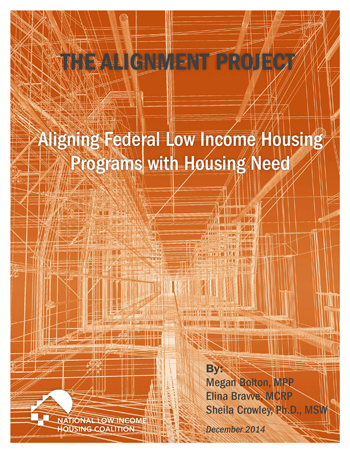NLIHC undertook the Alignment Project in order to gain a better understanding of how existing federal housing resources are being used and to learn how those existing resources might be better aligned with the need for housing among ELI households. A series of research reports and policy recommendations will result from the Alignment Project.
The first product of this project is the report, Aligning Federal Low Income Housing Programs with Housing Need, released in December 2014. In this report NLIHC found that while the Low Income Housing Tax Credit (LIHTC) program and other programs do serve extremely low income (ELI) households, those with incomes at or below 30% of area median income (AMI), they rarely do so without relying on housing vouchers. The report also features innovative strategies used by affordable housing developers to achieve deep affordability in their properties without relying on vouchers and includes five case studies of such properties.
NLIHC will host a webinar to discuss the findings from this report on January 14, 2015 from 2:00pm to 3:30pm Eastern. Register here.
NLIHC Supports:
- Income Averaging in LIHTC. NLIHC’s 2015-2016 Policy Agenda now includes a proposal to change the federal LIHTC statute to provide for a third income targeting criterion. This option would require that at least 40% of the units in a project would have to be occupied by residents with incomes that average no more than 60% of AMI, with at least 30% of the units rent restricted and occupied by tenants with incomes at or below 30% AMI. No rent-restricted units would include households with incomes above 80% of AMI. For purposes of computing the average, any unit with an income limit that is less than 20% of AMI would be treated as having a 20% limit. Rents would be based on 30% of the income limit in that unit, i.e., the rent in a 20% AMI unit would be 30% of 20% of AMI.
- Basis Boost in LIHTC. NLIHC also adopted a second policy position regarding LIHTC to change the federal LIHTC statute to provide a 30% basis boost for properties that use NLIHC’s proposed new third criterion of income averaging.
- QAPs. NLIHC encourages more state housing finance agencies to prioritize projects that serve special needs populations or ELI households in their QAPs. They could do this by allowing higher developer fees for projects that serve ELI households, establishing set-asides, or requiring a certain percentage of all developments to reserve units for ELI or special needs populations.
- State and local housing rental housing funding. NLIHC encourages states and localities that are using their own general revenue or have created dedicated funds for rental housing to prioritize serving ELI households if they are not already doing so.
- Intersection between LIHTC and HCVs. NLIHC encourages greater inquiry by multiple researchers to better understand how LIHTC developers are using HCVs and the degree to which HCVs are subsidizing LIHTC properties. This includes knowing how widespread the use of HCVs to cross subsidize other ELI households is.
- More and better data. NLIHC will pursue policy changes to require that HUD, Treasury, and the Federal Home Loan Banks expand and improve the regular collection and public availability of data on:
- characteristics, including income, age, race, gender, family status, and disability, of tenants in LIHTC, HOME, and AHP assisted properties, and
- all forms of financial subsidy in every federal assisted property, including the number and value of tenant-based and project-based vouchers.
- More research. This study reported the known available data on income targeting for LIHTC, HOME, and AHP, and did original data collection to learn more about ELI households living in LIHTC properties. Time and research constraints prevented the same kind of in-depth research of HOME and AHP. NLIHC encourages more project level research to understand the intersection between these programs and HCVs, and their ability to achieve deeper income targeting without vouchers. Also, NLIHC encourages and supports analysis of how states can use Medicaid expansion to create more supportive housing across the country.
For more information on the Alignment Project, contact Andrew Aurand, Vice President for Research, at [email protected], or 202.662.1530 x244. Members of the media should contact Renee Willis, Vice President for Field and Communications, at 202.662.1530 x247 or [email protected].
